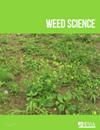Germination Responses of Vipergrass (Dinebra retroflexa) to Environmental Factors and Herbicide Options for Its Control
IF 2.1
2区 农林科学
Q2 AGRONOMY
引用次数: 0
Abstract
Abstract Vipergrass [Dinebra retroflexa (Vahl) Panzer] is an annual weed of the Poaceae family distributed in several parts of Australia, Asia, and Europe. Very limited information is available on its germination response to different environmental conditions. Knowledge of its seed ecology and biology could help in formulating better weed management decisions. Experiments were conducted to study the effect of alternating temperatures, light conditions, salt stress, water stress, seed burial depths, and wheat residue amounts on the germination or emergence of D. retroflexa. Also, different pre- and postemergence herbicides were evaluated to control D. retroflexa. The highest germination (98%) was recorded at 30/20 C followed by 35/25 C (95%). Light was required for the germination of D. retroflexa. Germination decreased with an increase in sodium chloride (NaCl) concentrations. Even at 80 mM NaCl, 81% of seeds germinated, indicating D. retroflexa's high salt tolerance. Seed germination gradually decreased with an increase in water stress, and no germination was recorded at –0.8 MPa osmotic potential. The emergence of D. retroflexa decreased with an increase in seed burial depths. The highest germination (83%) was recorded for surface-sown seeds, and emergence was reduced to 0 at a burial depth of 2 cm. Seedling emergence decreased from 82% to 2% when the crop residue load was increased from 0 to 800 kg ha–1. Applications of preemergence herbicides (at field rates), such as diuron, isoxaflutole, pendimethalin, pyroxasulfone, S-metolachlor, terbuthylazine, and triallate, and postemergence herbicides, such as clethodim, haloxyfop-methyl, glufosinate, glyphosate, imazamox plus imazapyr (a commercial mixture), and paraquat, resulted in complete control (100%) of D. retroflexa. Knowledge gained from this study will help us to understand the potential spread of D. retroflexa to other areas and to formulate integrated weed management strategies for its effective control.毒草萌发对环境因子的响应及除草剂的选择
摘要Vipergrass[Dinebra retroflexa(Vahl)Panzer]是一种一年生Poaceae科杂草,分布在澳大利亚、亚洲和欧洲的几个地区。关于其对不同环境条件的发芽反应的信息非常有限。了解其种子生态学和生物学可以帮助制定更好的杂草管理决策。试验研究了交替温度、光照条件、盐胁迫、水分胁迫、种子埋深和小麦残留量对反曲弯孢的发芽或出苗的影响。此外,还对不同的羽化前和羽化后除草剂进行了评价,以控制反曲线虫。最高发芽率(98%)记录在30/20℃,其次是35/25℃(95%)。光照是反曲D.retroflexa发芽所必需的。随着氯化钠浓度的增加,发芽率降低。即使在80 mM NaCl下,81%的种子也发芽了,这表明D.retroflexa具有很高的耐盐性。种子发芽率随着水分胁迫的增加而逐渐降低,在–0.8 MPa渗透势下没有发芽记录。随着种子埋深的增加,后弯D.flexa的出现减少。地表播种种子的发芽率最高(83%),埋深2厘米时出苗率降至0。当作物残留量从0增加到800 kg ha–1时,幼苗出苗率从82%降至2%。使用孕前除草剂(按田间速率),如敌草隆、异恶唑、二甲戊灵、吡喃砜、S-甲草胺、terbuthylazine和triallate,以及出苗后除草剂,如氯托丁、卤代磺酰甲基、草膦、草甘膦、伊扎莫加伊扎吡(一种商业混合物)和百草枯,可完全控制(100%)反曲弯线虫。从这项研究中获得的知识将有助于我们了解D.retroflexa向其他地区的潜在传播,并制定有效控制其的综合杂草管理策略。
本文章由计算机程序翻译,如有差异,请以英文原文为准。
求助全文
约1分钟内获得全文
求助全文
来源期刊

Weed Science
农林科学-农艺学
CiteScore
4.60
自引率
12.00%
发文量
64
审稿时长
12-24 weeks
期刊介绍:
Weed Science publishes original research and scholarship in the form of peer-reviewed articles focused on fundamental research directly related to all aspects of weed science in agricultural systems. Topics for Weed Science include:
- the biology and ecology of weeds in agricultural, forestry, aquatic, turf, recreational, rights-of-way and other settings, genetics of weeds
- herbicide resistance, chemistry, biochemistry, physiology and molecular action of herbicides and plant growth regulators used to manage undesirable vegetation
- ecology of cropping and other agricultural systems as they relate to weed management
- biological and ecological aspects of weed control tools including biological agents, and herbicide resistant crops
- effect of weed management on soil, air and water.
 求助内容:
求助内容: 应助结果提醒方式:
应助结果提醒方式:


